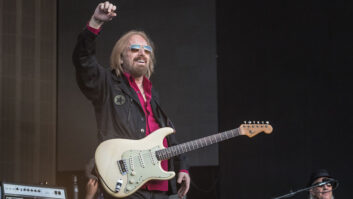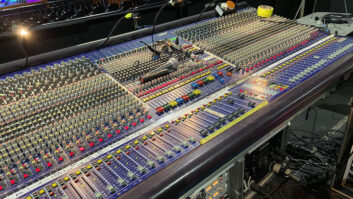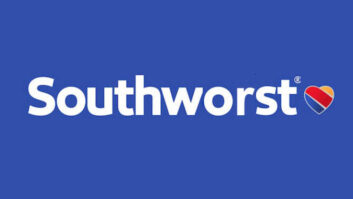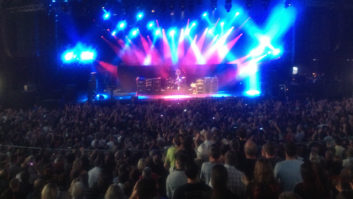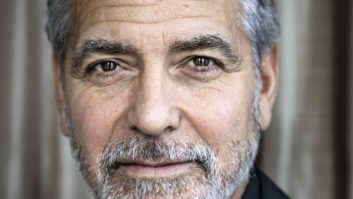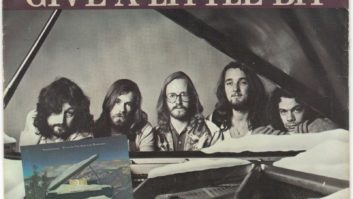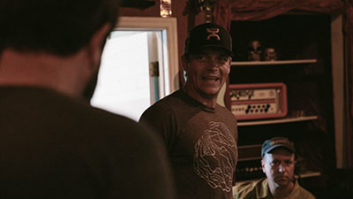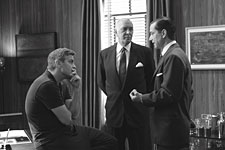

Photo: Melinda Sue Gordon (C) 2005 Good Night Good Luck LLC. All Rights Reserved.
For their critically acclaimed film, Good Night, and Good Luck, co-producers George Clooney and Grant Heslov wanted the activity on the CBS Radford Stage (Studio City, Calif.) to authentically represent television’s golden age. At one end, Edward R. Murrow delivered his hard-hitting See It Now program from a stiff armchair. Nearby, his team sat poised at the news desk. At the opposite end of the cavernous room, a stunning female jazz vocalist — played by three-time Grammy-winner Dianne Reeves — and a small combo rehearsed for an appearance on the variety show Shower of Stars later that night. In between and all around, producers and reporters rushed through the set, leaving trails of cigarette ashes and half-filled coffee cups behind them.
On a typical film, Reeves and her ace band would likely play (or pretend to play) to a prerecorded track, giving the sound team the ability to edit, EQ and remix music recorded later to fit the film and CD soundtrack. But Clooney took a different approach, opting to record the music live on the set in one pass. Production sound mixer Edward Tise, known for his work with director Stanley Kubrick, tackled that job with excellent results, navigating around simultaneous dialog recording, dodging film cameras and working with “period” microphones that would both look and sound authentic.
Tise didn’t know it at the time, but those undoctored live recordings would comprise almost half of Good Night, and Good Luck‘s CD soundtrack. Leslie Ann Jones, a respected engineer in music, film and television, as well as Skywalker Sound’s director of music recording and scoring, faced an equally challenging task: record nine songs to fill out the soundtrack that would match Tise’s on-the-set recordings, both sonically and stylistically, and then mix the entire album so that everything sounds like it was recorded within feet of Murrow in the early 1950s.
By recording live on the set, Tise could apply Clooney’s primary intention — to make the viewer feel like they’re in the moment — to the music. Meanwhile, music supervisor Allen Sviridoff had to find songs that fit the time period, setting and mood; considering Murrow reportedly loved jazz, Sviridoff and Clooney opted for a collection of smoky standards. “The songs comment on the action, so the lyrics had to work, as well as the music,” says Sviridoff. “We also wanted to find a balance of ballads and up-tempo songs.”
Clooney chose the classic “How High the Moon” early in the planning process, but he heard it as a slow, haunting ballad — an unusual arrangement for this swinging standard. Matt Catingub rearranged the song to match Clooney’s idea and the movie’s more somber mood. For the remaining tracks, Sviridoff combed through 2,000 songs to find 200 potential cuts, and then met with Clooney to whittle the list to the soundtrack’s final 15. Catingub then worked with Clooney and Sviridoff to rework almost every song, resulting in a slowed-down “Straighten Up and Fly Right,” a mysterious “I’ve Got My Eyes on You” and a version of “One for My Baby” that trumped Sviridoff and Catingub’s original cut for the closing credits, “Who’s Minding the Store?”
“He loved the way we did that song,” says Sviridoff, who worked as road and personal manager and producer for Rosemary Clooney (George Clooney’s aunt) beginning in 1978. “I had suggested to Rosemary Clooney in 1983, when we recorded her version of the Harold Arlen classic, that she sing it with just a guitar. We told Matt we wanted to make the film version as sparse as Rosemary’s layout. We really knocked ourselves out on that one, but we keep saying proudly that it was Harold Arlen and [co-writer] Johnny Mercer that knocked us out.”
Reeves, who had previously knocked them out with her demo video, soon found herself off of a European tour and in Hollywood at CBS Studio Center Stage where she joined Catingub (tenor and alto sax), Peter Martin (piano), Jeff Hamilton (drums) and Christoph Luty (bass) to perform on camera.
Tise recorded the group with an Aaton Cantar 8-track hard disk recorder and Sonosax 10-channel mixer, often setting aside two tracks for the dialog happening at the same time. “We would go straight from doing a scene with Edward R. Murrow and the boys in the bullpen to Dianne Reeves,” says Tise, who also worked on the Clooney-starred/directed Confessions of a Dangerous Mind. “I started focusing on this two days in advance. I knew how the art department wanted to set up the set and I had a rough idea of the band setup, although I originally thought there were three musicians.”
Art, audio and artist agreed that a Neumann U47 — Clooney built several key shots around this “working period mic” — made a fine choice for a vocal mic. A lone props supplier insisted that CBS would never use such an expensive mic in its TV studios, so maybe they compromised.
Tise placed a Schoeps PZM mic on the lid of the piano, and used an RCA DX77 ribbon mic (nabbed off of Murrow’s desk) for the bass and a 1960s Schoeps CMT501 stereo mic — hung above the band — for the drums and sax. He also hid a few modern condensers near the bass and sax. Rightly assuming that Clooney would want to hear the music from a distance, Tise set aside one track for a room mic, placing a Schoeps boundary-layer mic “miles away” from the band near the lighting rig. The room mic ended up serving dual purposes. “When I finally had time to listen back, I thought, ‘You know, what’s missing is the cymbals,’” says Tise. “I brought the fader up in playback on that boundary-layer Schoeps, which was 100 feet away, and there were the cymbals! They were the only things that carried with any clarity up to that microphone.”
Monitoring on headphones, Tise recorded straight into the Aaton, with no outboard gear; apparently, it wasn’t needed. “The pre’s on the Aaton are stunning,” says Tise. “Nothing was limited. The music editors wanted to add some simple reverb, but George didn’t want it; he wanted to keep the recordings as they were. It took enormous courage to do that.”
The ball then fell into Jones’ court to record nine songs that matched Tise’s recordings in an acoustically sound recording studio with very different equipment. Again, Reeves came to Hollywood during a short break from touring, but this time, she met Jones, engineer Charles Paakkari (who assisted Jones and mixed a portion of the songs) and Sviridoff at Capitol Studios, a fitting choice considering that its 50-year history includes 19 Frank Sinatra albums and recordings by Ella Fitzgerald, Nat King Cole, Harry Connick Jr. and Diana Krall, among many others. Jones knew the room well, having spent nine years there as an engineer before joining Skywalker Sound in 1997. She set up the band (the same musicians who played in the movie, with the exception of bassist Robert Hurst) together in Studio A’s 1,500-square-foot room. Reeves had initially planned to sing in the main room with the band, but because her schedule left her with limited time, they took a safer route and set her up in the studio’s large 11×12 iso booth. Through the magic of clever engineering, however, Jones still got Reeves’ voice in the live room. “After we were done recording, I shot Dianne’s vocals back into the room and recorded room tracks of her vocal for all of the tunes,” says Jones. “That’s what made it sound exactly like it sounded in the [TV] studio,” adds Sviridoff. “That’s the genius of Leslie Jones.”
Like Tise, Jones used a mix of old and new equipment. She used most of the same mics, including the classic Neumann U47 for Reeves, but ran them through vintage Neve mic pre’s and EQs to help replicate the sound on the set. Aside from that, much of the ambience came from the studio’s acoustics and the musicians, who not only played flawlessly, but could also offer input based on their experience at CBS Studios.
From the modern world, Jones recorded through a Neve VR60 console to Pro Tools HD. There were no overdubs; even Reeves, despite concerns about her voice, sang spot-on. For the mix, Jones and crew moved the HD rig to Capitol’s Studio C and worked on its Neve VRQ72. Jones first put up Tise’s recordings, which were mostly mono and had a lot of leakage, but sounded “amazingly quiet,” considering the circumstances. “For the first couple of hours, I went back and forth between one of his takes and one of mine, and made adjustments so that they sounded pretty much the same,” says Jones. “It was important to establish a sound with Edward’s tracks because I had the least amount of choices in terms of placement and EQ. So I needed to make that work first, and then I just tailored my mixes to resemble his.”
The challenge, says Jones, was to use this leakage in a way that would give Clooney and Sviridoff the sound they wanted, without letting it hamper the mix. Clooney, in Italy by this time working on another film, suggested changes and approved mixes over the phone.
Engineer Ron McMaster added the final touches at Capitol Mastering. Fittingly, Concord Music Group, Rosemary Clooney’s label, released the soundtrack, only to watch it earn a Grammy (and TEC Award nomination) for Best Jazz Vocal Album. The trophy serves as a wonderful recognition for a project that challenged the norm on both creative and technical levels. “Every last person said, ‘That’s impossible! You can’t record on a soundstage and get good quality!’” says Sviridoff. “But I knew that if George and Ed Tise believed it, then we would get it. And it didn’t take anything extraordinary, just great miking and great care.”
Jones adds, “If you have players that know what they’re doing and good-sounding instruments, that’s 90 percent of it right there. Capturing what Allen and George Clooney wanted was the other 10 percent.”

